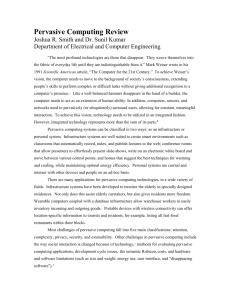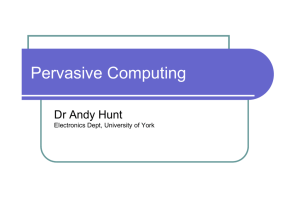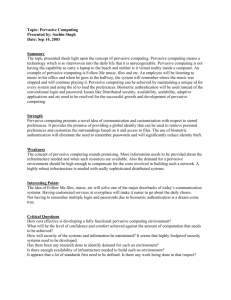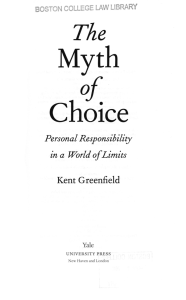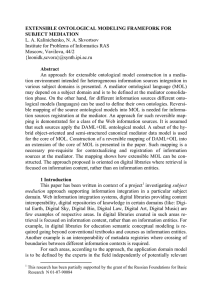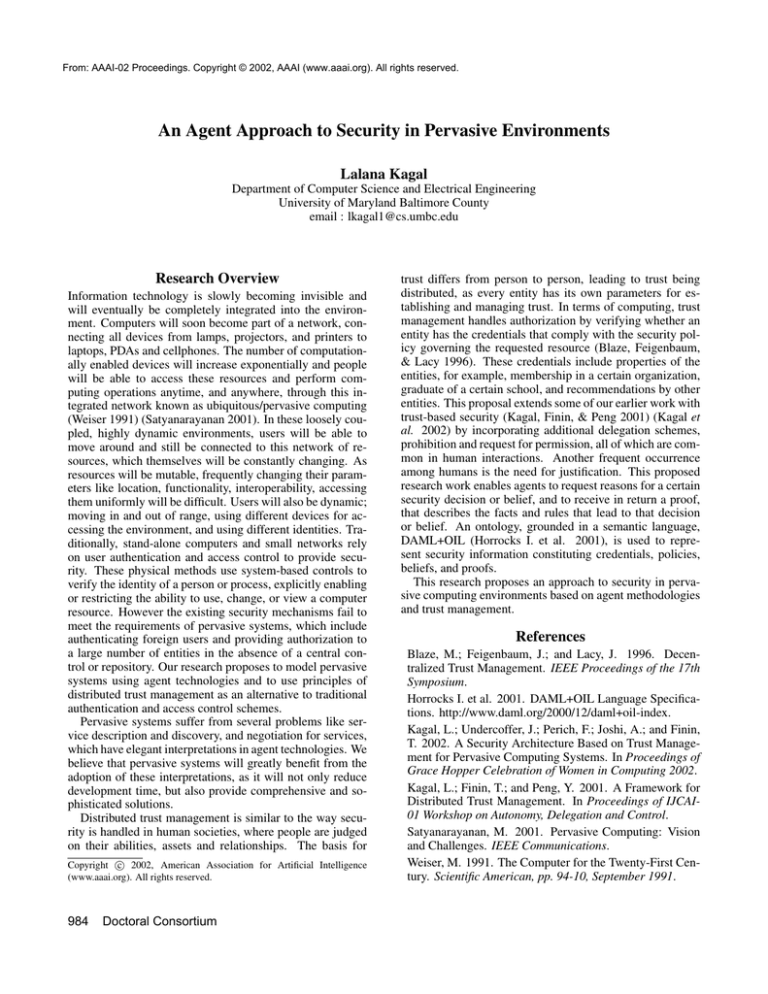
From: AAAI-02 Proceedings. Copyright © 2002, AAAI (www.aaai.org). All rights reserved.
An Agent Approach to Security in Pervasive Environments
Lalana Kagal
Department of Computer Science and Electrical Engineering
University of Maryland Baltimore County
email : lkagal1@cs.umbc.edu
Research Overview
Information technology is slowly becoming invisible and
will eventually be completely integrated into the environment. Computers will soon become part of a network, connecting all devices from lamps, projectors, and printers to
laptops, PDAs and cellphones. The number of computationally enabled devices will increase exponentially and people
will be able to access these resources and perform computing operations anytime, and anywhere, through this integrated network known as ubiquitous/pervasive computing
(Weiser 1991) (Satyanarayanan 2001). In these loosely coupled, highly dynamic environments, users will be able to
move around and still be connected to this network of resources, which themselves will be constantly changing. As
resources will be mutable, frequently changing their parameters like location, functionality, interoperability, accessing
them uniformly will be difficult. Users will also be dynamic;
moving in and out of range, using different devices for accessing the environment, and using different identities. Traditionally, stand-alone computers and small networks rely
on user authentication and access control to provide security. These physical methods use system-based controls to
verify the identity of a person or process, explicitly enabling
or restricting the ability to use, change, or view a computer
resource. However the existing security mechanisms fail to
meet the requirements of pervasive systems, which include
authenticating foreign users and providing authorization to
a large number of entities in the absence of a central control or repository. Our research proposes to model pervasive
systems using agent technologies and to use principles of
distributed trust management as an alternative to traditional
authentication and access control schemes.
Pervasive systems suffer from several problems like service description and discovery, and negotiation for services,
which have elegant interpretations in agent technologies. We
believe that pervasive systems will greatly benefit from the
adoption of these interpretations, as it will not only reduce
development time, but also provide comprehensive and sophisticated solutions.
Distributed trust management is similar to the way security is handled in human societies, where people are judged
on their abilities, assets and relationships. The basis for
c 2002, American Association for Artificial Intelligence
Copyright (www.aaai.org). All rights reserved.
984
Doctoral Consortium
trust differs from person to person, leading to trust being
distributed, as every entity has its own parameters for establishing and managing trust. In terms of computing, trust
management handles authorization by verifying whether an
entity has the credentials that comply with the security policy governing the requested resource (Blaze, Feigenbaum,
& Lacy 1996). These credentials include properties of the
entities, for example, membership in a certain organization,
graduate of a certain school, and recommendations by other
entities. This proposal extends some of our earlier work with
trust-based security (Kagal, Finin, & Peng 2001) (Kagal et
al. 2002) by incorporating additional delegation schemes,
prohibition and request for permission, all of which are common in human interactions. Another frequent occurrence
among humans is the need for justification. This proposed
research work enables agents to request reasons for a certain
security decision or belief, and to receive in return a proof,
that describes the facts and rules that lead to that decision
or belief. An ontology, grounded in a semantic language,
DAML+OIL (Horrocks I. et al. 2001), is used to represent security information constituting credentials, policies,
beliefs, and proofs.
This research proposes an approach to security in pervasive computing environments based on agent methodologies
and trust management.
References
Blaze, M.; Feigenbaum, J.; and Lacy, J. 1996. Decentralized Trust Management. IEEE Proceedings of the 17th
Symposium.
Horrocks I. et al. 2001. DAML+OIL Language Specifications. http://www.daml.org/2000/12/daml+oil-index.
Kagal, L.; Undercoffer, J.; Perich, F.; Joshi, A.; and Finin,
T. 2002. A Security Architecture Based on Trust Management for Pervasive Computing Systems. In Proceedings of
Grace Hopper Celebration of Women in Computing 2002.
Kagal, L.; Finin, T.; and Peng, Y. 2001. A Framework for
Distributed Trust Management. In Proceedings of IJCAI01 Workshop on Autonomy, Delegation and Control.
Satyanarayanan, M. 2001. Pervasive Computing: Vision
and Challenges. IEEE Communications.
Weiser, M. 1991. The Computer for the Twenty-First Century. Scientific American, pp. 94-10, September 1991.


